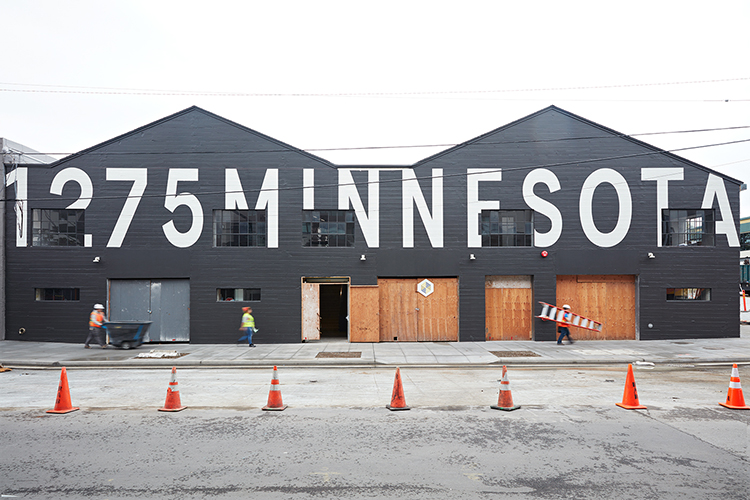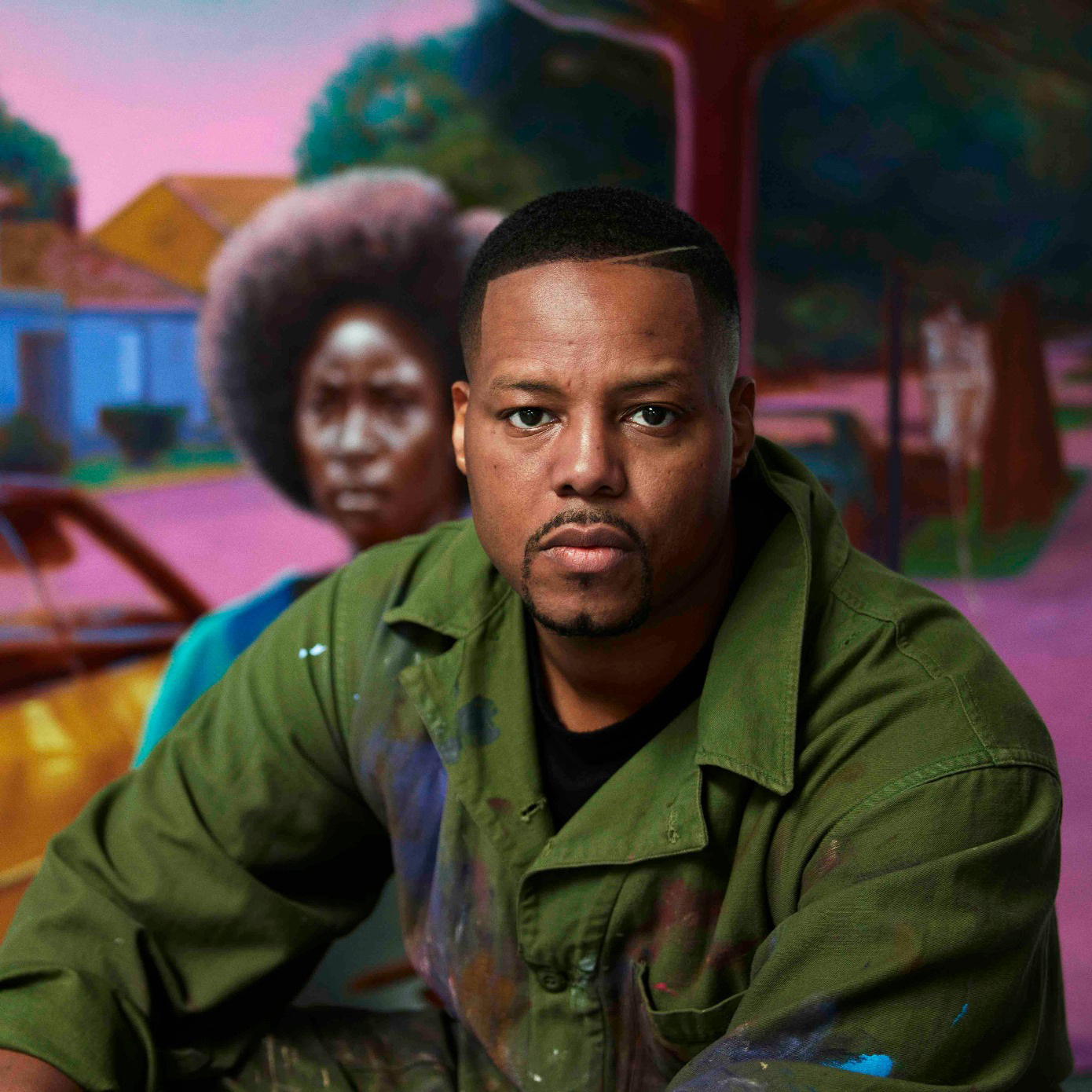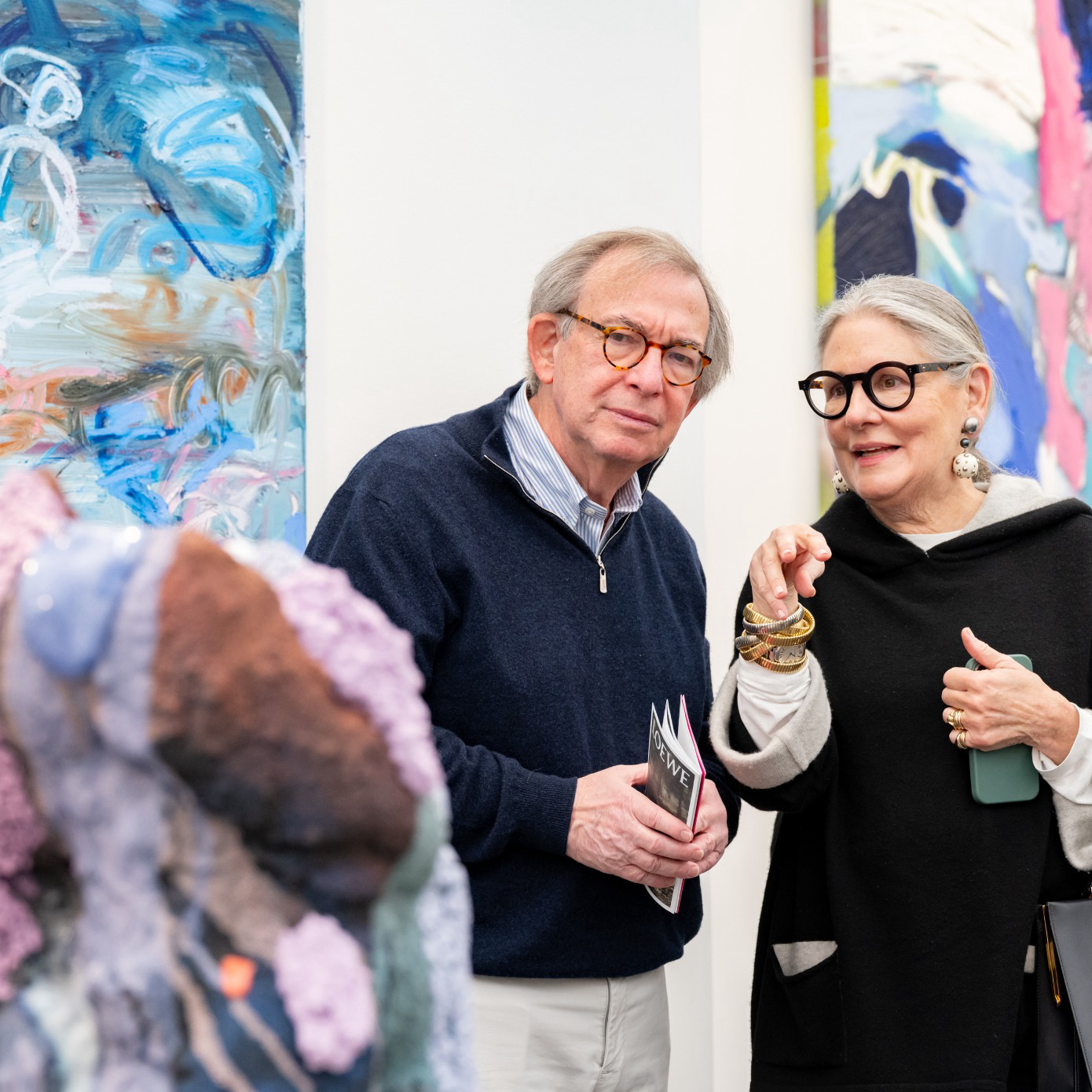
"You see these ripples?” asks Jeffrey Fraenkel, standing between Alexander Calder’s Big Crinkly and the 19,000-plant vertical garden on the third floor terrace of the San Francisco Museum of Modern Art’s shiny new Snøhetta-designed building. It’s the last Friday in April and the second hour of Art Bash, the VIP inauguration party for the seven-floor, 235,000-square-foot expansion—and what is being billed as the largest collection of contemporary art in the country.
Crowds of curators and critics devour towering displays of sushi while bustling teams of bartenders pump overly adorned cocktails from dancer-topped bars to a veritable United Nations of art stars and the collectors who follow them around the globe.
“Everyone is here for this,” quips Armory Show Executive Director Benjamin Genocchio. “The entire international community from the lowliest art handler to the loftiest artists and curators came together to make this happen.”
 Gallery owner Jeffrey Fraenkel. Photo by Justin Buell.
Gallery owner Jeffrey Fraenkel. Photo by Justin Buell.
The night before, all the heavies were descending on Fraenkel’s party (celebrating his gallery’s new Christian Marclay exhibition) at Mission Bowling Club, where Anselm Kiefer could be seen knocking down pins alongside SFMOMA Board President Bob Fisher, Mission School art legend Barry McGee and Bay Area-based photographer Katy Grannan. But tonight Fraenkel, who has almost single-handedly steered the Bay’s bluest-chip collections deep into silver gelatin, is busy staring up at the museum’s wave-like, fiberglass-reinforced polymer facade.
“It seems to me that this building will be sending ripples out into this city,” he says. “And it will change things.”
Like a giant asteroid that pulls a constellation of space debris into its orbit before entering the atmosphere, the May 14 landfall of the new SFMOMA undoubtedly attracted—or at the very least attracted attention to—a micro-galaxy of international galleries (Larry Gagosian, Pace, Anton Kern, Andrew Kreps), philanthropic endeavors (Minnesota Street Project, 500 Capp Street Foundation), entrepreneurial efforts (Untitled Art Fair) and institutional expansions (Berkeley Art Museum and Pacific Film Archive, Asian Art Museum) touching down around the broader Bay Area. And this is to say nothing of the recent ventures by the city’s top dealers—from the new FraenkelLab to Jessica Silverman helming a new project space and Yves Béhar’s Fused Space to Claudia Altman Siegel’s forthcoming Dogpatch digs and Ratio 3’s Mission Street gallery—or the fact that the FOG Design + Art Fair has tripled attendance and is already attracting the likes of Marian Goodman, David Zwirner and David Kordansky in the three short years since the museum closed for renovations.
“People always ask, ‘Why San Francisco?’ The real question is, ‘Why not?’” says Jeff Lawson, who next January will launch a second edition of his Untitled Art Fair—which debuted during Art Basel Miami Beach in 2012—inside the historic shipbuilding terminal at Pier 70, dovetailing with FOG. “I know that sounds so simple but when you really look at it, there are so many reasons: the Bay Area has world-class cultural institutions, great hotels, fine restaurants, historic and contemporary architecture and a good mix of established and emerging collectors.”
 Performers at SFMOMA’s Art Bash. Photo by Devlin Shand for Drew Altizer Photography/SFWire.
Performers at SFMOMA’s Art Bash. Photo by Devlin Shand for Drew Altizer Photography/SFWire.
Rather than fearing the addition of another fair, FOG steering committee member Douglas Durkin welcomes the notion. “This is actually very exciting as it means that there is a growing faith in the marketplace and culture here,” says Durkin. “We have often mused about the idea that FOG would be the genesis of a dedicated art and design week here in the Bay Area, and there are now brewings of just that happening.”
This faith has even inspired the high priest of the market, Larry Gagosian, who just opened his 16th location in a relatively modest 4,500-square-foot ground-floor space (designed by Kulapat Yantrasast) at the Crown Point Press building. Just across the street from SFMOMA, it neighbors the space where veteran San Francisco dealer John Berggruen will relocate his operation after 45 years on Grant Avenue. Gagosian says, “It was the right time for San Francisco.” Of course, timing isn’t the only consideration.
“We’ve had really established clients in San Francisco for a long time and there are obviously the young tech collectors, but that’s not the driving force—it’s more about being here,” adds Anna Gavazzi Asseily, who left Gagosian London to serve as director of the new gallery. During a tour of the almost-ready space (as workers were busy painting floors and installing works to the walls) the day before Art Bash, she explains, “There’s never a tipping point, but Larry saw the space and he loved it.”
 Gagosian Gallery’s recently inaugurated San Francisco space. Photo ©M-Projects, courtesy Gagosian Gallery.
Gagosian Gallery’s recently inaugurated San Francisco space. Photo ©M-Projects, courtesy Gagosian Gallery.
For Pace’s Marc Glimcher, who opened his 20,000-square-foot temporary Pace Art + Technology outpost inside a former Tesla showroom in February with 20 digital works from TeamLab, it was also a matter of location, location, location. Unlike Gagosian, however, Glimcher decided to plant roots two months later—with a permanent space—in a downtown Palo Alto location. “Silicon Valley represents the nexus of exploration and innovation,” says Liz Sullivan, president of Pace Palo Alto. “It’s where creativity meets advanced function, and art is an open discussion.” They seemed to strike a chord: The Wednesday before Art Bash, Pace Palo Alto’s inaugural show with James Turrell drew a line that extended out the door for two blocks.
“When I first moved to San Francisco, the city felt like a snow globe. New Yorkers kept an eye on what was happening here but few actually came and stepped foot on Bay Area soil,” says Jessica Silverman, whose exhibition of Isaac Julien’s photographs about gay black desire from his award-winning Looking for Langston series drew everyone from Takashi Murakami to Jeanne Greenberg Rohatyn and Noah Horowitz, Art Basel’s Director Americas. “There is nothing more gratifying than people standing in your space, experiencing the real scale and sensuality of ambitious work.”
The question, then, is really not if something is happening in San Francisco—it is—but rather what all this activity will do to (and for) the city in the years to come as the cost of living continues to rise and techrification continues to displace more local artists.
“The cost of living is a challenge, there’s no question about it, and one of the things we all need to be concerned about is that San Francisco is not just a place where art is consumed but also created,” says Neal Benezra, director of SFMOMA. He points to the Minnesota Street Project—an exhibition and studio complex (where 37 artists have already secured affordable spaces) developed by philanthropists Andy and Deborah Rappaport in the formerly down-at-the-heels Dogpatch district—as a possible model for the future.
“Sometimes you have to think a bit outside of the box and yesterday there were so many curators here, the response was so positive,” says Anton Kern, who staged a three-week pop-up exhibition (featuring works by Pae White, Anne Collier and Andrea Bowers, among others) with fellow New York dealer Andrew Kreps in two of the Minnesota Street Project’s second-floor spaces. “I can obviously see there are things going on with Silicon Valley and people have a lot of money, but I don’t want to think about this so much. I would rather focus on the art.”
 Laura Owens’ “Ten Paintings” at the Wattis Institute.
Laura Owens’ “Ten Paintings” at the Wattis Institute.
At the California College of the Arts’s nearby Wattis Institute for Contemporary Art, Los Angeles-based artist Laura Owens drew a similarly curator-heavy crowd for a show of new paintings, artist books and an installation of more than 70 unique, non-repeating strips of handmade “wallpaper.” Visitors were able to text questions to the installation, prompting a sound component that responded with one of 1,000 sound clips (field recordings, voices, song samples) projected through loudspeakers embedded in the gallery walls.
“The ‘text a question’ is this appropriated thing from a bunch of pull quotes that are put together over the last 50 years from New York publications describing L.A. as this coming-of-age place,” says Owens. “When I heard about all this happening in San Francisco I was like, ‘Oh, great, L.A. doesn’t have to be the story anymore.’ It’s this provincialism where the other is finally going to be this contender against this de facto center, which is New York. But this story has been happening for so long it’s become a joke.”
Whether or not the “SF is the New L.A.” headline gains any traction though is still very much up for debate. “San Francisco is a sophisticated, beautiful city, which is the historical home of the hippies, gay liberation, the farm-to-table movement and tech culture,” says Cultured contributing editor and “33 Artists in 3 Acts” author Sarah Thornton, who spent more than 20 years in London before moving to the Bay Area in 2014. “I am thrilled that we now have a major contemporary art museum, but I’m also relieved that San Francisco is not an art world hub, with all the competitive aggression entailed. Here we like to refresh our eye by looking at the Bay.”
Claudia Altman Siegel, who opened a thoughtful exhibition of Jessica Dickinson’s fresco-like paintings and threw a massive barbecue in the shell of her forthcoming Dogpatch space that Thursday, said it was a joke that so many reporters still ask if the Bay Area will become the next Los Angeles. “Does anyone even think that?” she asked with a laugh in her back office. For her, the bigger, more enduring story is how the local galleries not only survived but thrived during the museum’s closure, laying a bedrock for future success in the process. “People could have easily gone elsewhere and been less interested in art in general while the museum was closed,” she says. “But it was almost like a bonding experience.”

Another bonding experience that seems to be playing out is the one amongst Bay Area collectors, 230 of which came together to donate some 3,000 works for The Campaign for Art for SFMOMA. They are also clearly coming together at the Pilara Foundation’s space, Pier 24 Photography. Nine top collectors (think Bob Fisher, John Pritzker, David Mahoney and Chara Schreyer) were invited to share their works in 17 different rooms in its bayside space.
“New York has huge volume, but San Francisco has a remarkable group of photography collectors and it’s not competitive,” says Pritzker, who created an elegant Robert Frank show from what is considered the deepest collection of the artist’s work in the world. “Bob Fisher and I have a fair amount of overlap, but we’ve never come up against each other for a piece, and even if we do it’s always collaborative.”
The group effort at Pier 24, titled “Collected,” offers a breadth of challenging, surprising work that acts as a refreshing contrast to the largely conservative opening gambit at SFMOMA, which opted for safer bets rather than confrontational material.
One pairing that didn’t seem so in sync: SFMOMA and local contemporary artists, who were rather short-shrifted within the museum’s 19 inaugural exhibitions. Katy Grannan and Catherine Opie, Bay Area icons past and present, were surprisingly absent from the photo exhibitions. Tom Marioni, Howard Fried and David Ireland, whose home in the Mission was turned into the 500 Capp Street Foundation, were relegated to a conceptualist corner. And the Mission School—the last core group of homegrown talents to work in the Bay Area, most of whom were shown by legendary San Francisco dealer Jack Hanley, who relocated to New York in 2008—were all but absent from the building. The one exception: I Do Not Know But Am Open to Learning, an inflatable patchwork fabric question mark sculpture atop the Howard Street entrance, by Chris Johanson, who decamped in 2003 and now splits his time between Portland, Oregon, and Los Angeles.
“I’m not interested in competition and capitalism. That town became super expensive, and when places become totally expensive they’re just not interesting places anymore. That’s some alpha capitalism lifestyle shit,” says Johanson, whose departure was a result of rising rents and the disconnect between the collector base and artists like himself. “I was a high-end house painter in that town. I painted mansions in Pacific Heights and now my art is in some of the houses in that neighborhood. But I never got to know any of those people. Those people were never really interested in the Jack Hanley gallery, Four Walls, Kiki or the other small spaces.”
Hanley agrees with Johanson. “It seems to me that there’s a certain provincial thing in most cities that are smaller. Collectors feel like they’re not getting the best work unless they go to what they perceive as the source. But it’s not really true,” says Hanley, who actually thought about leaving San Francisco in 1996, just after SFMOMA moved to its Third Street location, but stayed on another decade despite diminishing returns on the gallery front. “A lot of artists could be really good artists in San Francisco but unless they made it outside in New York or Europe they were always looked at as local artists. I showed Cathy Opie early on and couldn’t sell anything. A lot of people must have thought I was cleaning up with the tech people, but I don’t think I sold any work to them. They didn’t care at all.”
 Snøhetta meets Mario Botta in the original museum atrium, whose centerpiece is a 1963 mobile by Alexander Calder. Photo ©Iwan Baan, courtesy SFMOMA.
Snøhetta meets Mario Botta in the original museum atrium, whose centerpiece is a 1963 mobile by Alexander Calder. Photo ©Iwan Baan, courtesy SFMOMA.
Most artists—aside from the most established—are now forced to reside in Oakland. “I don’t believe the SFMOMA has ever been interested in living San Francisco artists,” says Barry McGee, who still lives in the Mission with his artist wife, Clare Rojas. As collectors sipped Champagne and ate caviar-topped blinis while Cory Arcangel’s All the Parts From Simon and Garfunkel’s 1984 Central Park Performance Where Garfunkel Sings With His Hands in His Pockets played on the fourth floor, McGee danced around on the fifth, alongside Alicia McCarthy, Brad Kahlhamer and Hanley, who was spinning in circles and gagging the party photographers to the noise rock stylings of Johanson’s band, Sun Foot. McGee agreed that a lot of his contemporaries had been displaced to Oakland, Los Angeles and beyond. Still, he welcomed the changes the museum seemed to be bringing to his town, even if SFMOMA was running a little light on the SF.
“I wish this would have happened faster,” he said. “I’m not anti-anything. I’m into it. I don’t like things when they stay the same. If it all stays the same it’s not that fun, either.”
It reminded me of something Fraenkel mentioned downstairs a few hours earlier when asked what the future holds for the city. “This will be the next San Francisco,” he told me. By “next,” I think he meant a new chapter in which the city embraces all its haute-hippie incongruities: DIY and luxury lifestyles; gay and straight; institutional collectors and subversive underground artists; international art fairs and Minnesota Street Projects; Tosca at the Opera and Johanson, dressed in one of his signature Hawaiian shirts, shouting, “I heard it before, I heard it before, I heard it before...Peace War, Peace War...Fuck No...Peace War.” Either way, a revolution is afoot.




